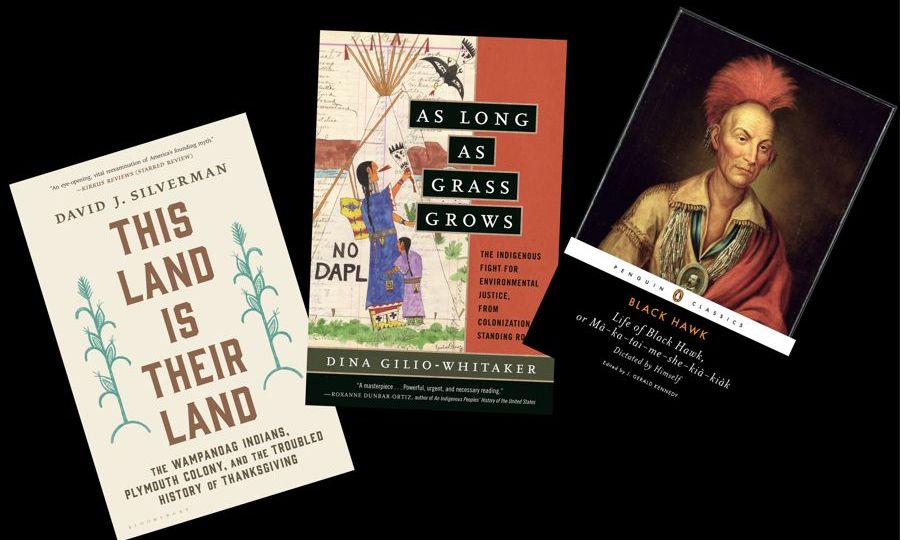
Celebrating Thanksgiving by telling stories about the Plymouth Puritans and their descendants is a common American tradition… but it only tells half the story. This season of remembrance and reflection is the perfect time to listen to the stories told at the same time, in the same places, as the stories we might already know: the stories of the people who were here first.
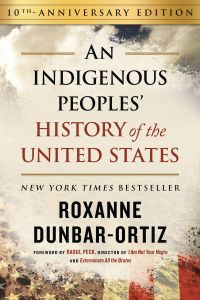
An Indigenous Peoples’ History of the United States (10th Anniversary Edition)
Roxanne Dunbar-Ortiz
Beacon Press
Unflinchingly honest about the brutality of this nation’s founding and its legacy of settler-colonialism and genocide, the impact of Roxanne Dunbar-Ortiz’s 2014 book is profound. This classic is revisited with new material that takes an incisive look at the post-Obama era from the war in Afghanistan to Charlottesville’s white supremacy-fueled rallies, and from the onset of the pandemic to the election of President Biden. Writing from the perspective of the peoples displaced by Europeans and their white descendants, she centers Indigenous voices over the course of four centuries, tracing their perseverance against policies intended to obliterate them. Today in the United States, there are more than five hundred federally recognized Indigenous nations comprising nearly three million people, descendants of the fifteen million Native people who once inhabited this land. The centuries-long genocidal program of the US settler-colonial regimen has largely been omitted from history. With a new foreword from Raoul Peck and a new introduction from Dunbar Ortiz, this classic bottom-up peoples’ history explodes the silences that have haunted our national narrative.

As Long as Grass Grows : The Indigenous Fight for Environmental Justice, from Colonization to Standing Rock
Dina Gilio-Whitaker
Beacon Press
Through the unique lens of “Indigenized environmental justice,” Indigenous researcher and activist Dina Gilio-Whitaker explores the fraught history of treaty violations, struggles for food and water security, and protection of sacred sites, while highlighting the important leadership of Indigenous women in this centuries-long struggle. As Long As Grass Grows gives readers an accessible history of Indigenous resistance to government and corporate incursions on their lands and offers new approaches to environmental justice activism and policy. Throughout 2016, the Standing Rock protest put a national spotlight on Indigenous activists, but it also underscored how little Americans know about the longtime historical tensions between Native peoples and the mainstream environmental movement. Ultimately, she argues, modern environmentalists must look to the history of Indigenous resistance for wisdom and inspiration in our common fight for a just and sustainable future.
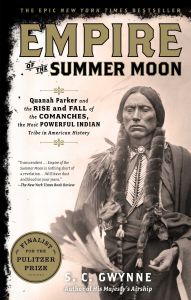
Empire of the Summer Moon
S.C. Gwynne
Scribner
Although readers may be more familiar with the tribal names Apache and Sioux, it was in fact the legendary fighting ability of the Comanches that determined when the American West opened up. Comanche boys became adept bareback riders by age six; full Comanche braves were considered the best horsemen who ever rode. They were so masterful at war and so skillful with their arrows and lances that they stopped the northern drive of colonial Spain from Mexico and halted the French expansion westward from Louisiana. White settlers arriving in Texas from the eastern United States were surprised to find the frontier being rolled backward by Comanches incensed by the invasion of their tribal lands. The war with the Comanches lasted four decades, in effect holding up the development of the new American nation. Gwynne’s exhilarating account delivers a sweeping narrative that encompasses Spanish colonialism, the Civil War, the destruction of the buffalo herds, and the arrival of the railroads, and the amazing story of Cynthia Ann Parker and her son Quanah—a historical feast for anyone interested in how the United States came into being.
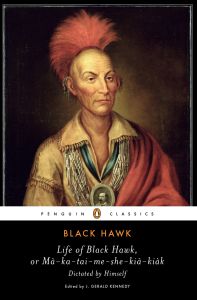
Life of Black Hawk, or Ma-ka-tai-me-she-kia-kiak
Black Hawk
Penguin Classics
Upon its publication in 1833, this unflinching narrative by the vanquished Sauk leader Black Hawk was the first thoroughly adversarial account of frontier hostilities between white settlers and Native Americans. Black Hawk, a complex, contradictory figure, relates his life story and that of his people, who had been forced from western Illinois in what was known as the Black Hawk War. The first published account of a victim of the American war of extermination, this vivid portrait of Indian life stands as a tribute to the author and his extraordinary people, as well as an invaluable historical document.

Holding Our World Together : Ojibwe Women and the Survival of Community
Brenda J. Child
Penguin Books
In this well-researched and deeply felt account, Brenda J. Child, a professor and a member of the Red Lake Ojibwe tribe, gives Native American women their due, detailing the many ways in which they have shaped Native American life. She illuminates the lives of women such as Madeleine Cadotte, who became a powerful mediator between her people and European fur traders, and Gertrude Buckanaga, whose postwar community activism in Minneapolis helped bring many Indian families out of poverty. Moving from the early days of trade with Europeans through the reservation era and beyond, Child offers a powerful tribute to the courageous women who sustained Native American communities through the darkest challenges of the past three centuries.
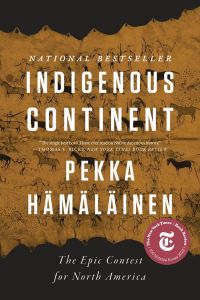
Indigenous Continent
Pekka Hämäläinen
Liveright
There is an old, deeply rooted story about America that goes like this: Columbus “discovers” a strange continent and brings back tales of untold riches. The European empires rush over, eager to stake out as much of this astonishing “New World” as possible. Though Indigenous peoples fight back, they cannot stop the onslaught. White imperialists are destined to rule the continent, and history is an irreversible march toward Indigenous destruction. Yet as with other long-accepted origin stories, this one, too, turns out to be based in myth and distortion. In Indigenous Continent, acclaimed historian Pekka Hämäläinen presents a sweeping counternarrative that shatters the most basic assumptions about American history. Shifting our perspective away from Jamestown, Plymouth Rock, the Revolution, and other well-trodden episodes on the conventional timeline, he depicts a sovereign world of Native nations whose members, far from helpless victims of colonial violence, dominated the continent for centuries after the first European arrivals. From the Iroquois in the Northeast to the Comanches on the Plains, and from the Pueblos in the Southwest to the Cherokees in the Southeast, Native nations frequently decimated white newcomers in battle. Even as the white population exploded and colonists’ land greed grew more extravagant, Indigenous peoples flourished due to sophisticated diplomacy and leadership structures. Hämäläinen ultimately contends that the very notion of “colonial America” is misleading, and that we should speak instead of an “Indigenous America” that was only slowly and unevenly becoming colonial. The evidence of Indigenous defiance is apparent today in the hundreds of Native nations that still dot the United States and Canada. Necessary reading for anyone who cares about America’s past, present, and future, Indigenous Continent restores Native peoples to their rightful place at the very fulcrum of American history.



Indigenous Continent
Pekka Hämäläinen
Liveright
There is an old, deeply rooted story about America that goes like this: Columbus “discovers” a strange continent and brings back tales of untold riches. The European empires rush over, eager to stake out as much of this astonishing “New World” as possible. Though Indigenous peoples fight back, they cannot stop the onslaught. White imperialists are destined to rule the continent, and history is an irreversible march toward Indigenous destruction. Yet as with other long-accepted origin stories, this one, too, turns out to be based in myth and distortion. In Indigenous Continent, acclaimed historian Pekka Hämäläinen presents a sweeping counternarrative that shatters the most basic assumptions about American history. Shifting our perspective away from Jamestown, Plymouth Rock, the Revolution, and other well-trodden episodes on the conventional timeline, he depicts a sovereign world of Native nations whose members, far from helpless victims of colonial violence, dominated the continent for centuries after the first European arrivals. From the Iroquois in the Northeast to the Comanches on the Plains, and from the Pueblos in the Southwest to the Cherokees in the Southeast, Native nations frequently decimated white newcomers in battle. Even as the white population exploded and colonists’ land greed grew more extravagant, Indigenous peoples flourished due to sophisticated diplomacy and leadership structures. Hämäläinen ultimately contends that the very notion of “colonial America” is misleading, and that we should speak instead of an “Indigenous America” that was only slowly and unevenly becoming colonial. The evidence of Indigenous defiance is apparent today in the hundreds of Native nations that still dot the United States and Canada. Necessary reading for anyone who cares about America’s past, present, and future, Indigenous Continent restores Native peoples to their rightful place at the very fulcrum of American history.
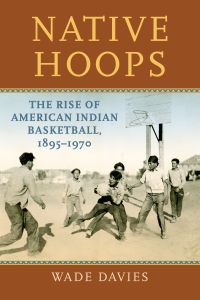

Native Hoops: The Rise of American Indian Basketball
Wade Davies
University Press of Kansas
A prominent Navajo educator once told historian Peter Iverson that “the five major sports on the Navajo Nation are basketball, basketball, basketball, basketball, and rodeo.” The Native American passion for basketball extends far beyond the Navajo, whether on reservations or in cities, among the young and the old. Why basketball—a relatively new sport—should hold such a place in Native culture is the question Wade Davies takes up in Native Hoops. Indian basketball was born of hard times and hard places, its evolution traceable back to the boarding schools—or “Indian schools”—of the early twentieth century. Davies describes the ways in which the sport, plied as a tool of social control and cultural integration, was adopted and transformed by Native students for their own purposes, ultimately becoming the “Rez ball” that embodies Native American experience, identity, and community. Native Hoops travels the continent, from Alaska to North Carolina, tying the rise of basketball—and Native sports history—to sweeping educational, economic, social, and demographic trends through the course of the twentieth century. Along the way, the book highlights the toils and triumphs of well-known athletes, like Jim Thorpe and the 1904 Fort Shaw girl’s team, even as it brings to light the remarkable accomplishments of those whom history has, until now, left behind. The first comprehensive history of American Indian basketball, Native Hoops tells a story of hope, achievement, and celebration—a story that reveals the redemptive power of sport and the transcendent spirit of Native culture.
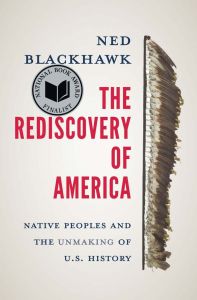

The Rediscovery of America: Native Peoples and the Unmaking of U.S. History
Ned Blackhawk
Yale University Press
A sweeping and overdue retelling of U.S. history that recognizes that Native Americans are essential to understanding the evolution of modern America. The most enduring feature of U.S. history is the presence of Native Americans, yet most histories focus on Europeans and their descendants. This long practice of ignoring Indigenous history is changing, however, with a new generation of scholars insists that any full American history address the struggle, survival, and resurgence of American Indian nations. Indigenous history is essential to understanding the evolution of modern America. Ned Blackhawk interweaves five centuries of Native and non‑Native histories, from Spanish colonial exploration to the rise of Native American self-determination in the late twentieth century. In this transformative synthesis he shows that European colonization in the 1600s was never a predetermined success; Native nations helped shape England’s crisis of empire; the first shots of the American Revolution were prompted by Indian affairs in the interior; California Indians targeted by federally funded militias were among the first casualties of the Civil War; the Union victory forever recalibrated Native communities across the West; and how twentieth-century reservation activists refashioned American law and policy. Blackhawk’s retelling of U.S. history acknowledges the enduring power, agency, and survival of Indigenous peoples, yielding a truer account of the United States and revealing anew the varied meanings of America.
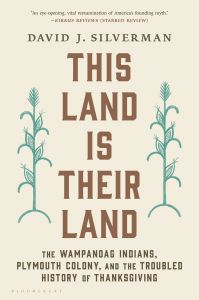

This Land Is Their Land: The Wampanoag Indians, Plymouth Colony, and the Troubled History of Thanksgiving
David J. Silverman
Bloomsbury Publishing
In March 1621, when Plymouth’s survival was hanging in the balance, the Wampanoag sachem (or chief), Ousamequin (Massasoit), and Plymouth’s governor, John Carver, declared their people’s friendship for each other and a commitment to mutual defense. Later that autumn, the English gathered their first successful harvest and lifted the specter of starvation. Ousamequin and 90 of his men then visited Plymouth for the “First Thanksgiving.” The treaty remained operative until King Philip’s War in 1675, when 50 years of uneasy peace between the two parties would come to an end. Four hundred years after that famous meal, historian David J. Silverman sheds profound new light on the events that led to the creation, and bloody dissolution, of this alliance. Focusing on the Wampanoag Indians, Silverman deepens the narrative to consider tensions that developed well before 1620 and lasted long after the devastating war—tracing the Wampanoags’ ongoing struggle for self-determination up to this very day. This unsettling history reveals why some modern Native people hold a Day of Mourning on Thanksgiving, a holiday which celebrates a myth of colonialism and white proprietorship of the United States. This Land Is Their Land shows that it is time to rethink how we, as a pluralistic nation, tell the history of Thanksgiving.


